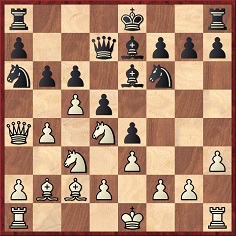
Edward Winter
A compendium of Chess Notes items about the moves 1 b4 (Section 1) and 1...b5 (Section 2).
Land and Water (21 June 1873) gives what is the earliest case of 1 b4 that we have seen. The Oxford Encyclopedia of Chess Games by Levy and O’Connell has no examples, so was Rev. A.B.Skipworth the first to play it, in 1868?
Arthur Bollard Skipworth – Cuthbertson
Challenge Cup Tourney, 1868
Polish Opening
(Notes from Land and Water)
1 b4 (‘We do not remember to have ever seen a game opened in this way before. It is certainly an ingenious novelty and deserves examination.’) 1...e5 2 Bb2 d6 (‘Better play than taking the pawn.’) 3 e3 c6 4 c4 Nf6 5 Bd3 Be7 6 Ne2 Na6 7 Qb3 e4 8 Bc2 Bg4 9 Nbc3 d5 10 c5 Qd7 11 h3 Be6 12 Nd4 b6 13 Qa4

13...Nxb4 (‘Cleverly played, but of somewhat doubtful soundness.’) 14 Nxe6 (‘Much better than taking the knight.’) 14...Nxc2+ 15 Qxc2 Qxe6 (‘15...fxe6 seems preferable.’) 16 cxb6 axb6 17 Ne2 Qd7 18 O-O O-O 19 f4 Qd6 20 Nd4 c5 21 Nf5 Qd7 22 g4 h6 23 Rf2 (‘White, though minus a pawn, has now a very formidable attack.’) 23...h5 (‘An irreparable error, of which White is not slow to avail himself.’) 24 Qd1 hxg4 25 hxg4 Rad8 26 Nxe7+ Qxe7 27 g5 Ne8 28 Qh5 d4 29 Rg2 and wins (‘29 Rh2 seems more immediately conclusive.’).
(55)
1 b4 e5 2 Bb2 Nc6 (‘A serious oversight, due to hasty play.’) 3 b5 Nce7 4 Bxe5, etc. (E. Delmar v F.J. Marshall, Brooklyn Chess Championship, 1906). Source: American Chess Bulletin, August 1906, page 164. Could this be a unique example of a leading player blundering at move two? (White won in 43 moves.)
(1745)
C.N. 2150 (see page 157 of Kings, Commoners and Knaves) drew attention to 1 e4 Nf6 2 Nf3 (Fischer v Thornell, Chicago, 1964).
The product of half a decade’s exertion, or inertia, was a 54-page booklet Débuts du jeu d’échecs with the subtitle ‘Leur désignation uniforme’, published in Prague in 1934 by officials of the Czechoslovakian Federation and revised by a FIDE Committee comprising Rueb, Przepiórka, Collijn, Grünfeld and Tartakower. Rueb’s introduction (page 6) described it as a first attempt at consistency (‘un premier effort vers la stabilisation de la nomenclature des débuts’) which did not claim to be complete, infallible or conclusive. Indeed, the term ‘avant-projet’ was still employed. A Preface by Louma stated that the ‘auteur du projet’ was Jaroslav Ferra.
By way of example, below are some of the fruits of the quinquennium:
(3902)
For more information about the booklet, see: Chess: The History of FIDE.
C.N. 601 referred to page 32 of Vienna, 1890 by Warren H. Goldman:
Berthold Englisch ‘is credited with having introduced the opening move 1 b4 into master practice’.
Marek Soszynski (Birmingham, England) asks:
‘Are there any games extant by Joseph Hunt (1851-1920) supporting his being described as “The Originator of the Hunt Opening (1 b4)”?’
We have yet to find any such games, and shall welcome readers’ assistance.
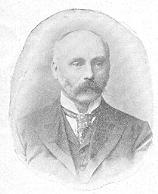
Joseph William Hunt
It was in the 1890s that the opening gained in familiarity (after Schlechter’s quick defeat of Fleissig in 1893, a famous game often misdated 1895), but at that time the heading ‘Irregular Opening’ was generally used. Hunt’s name was associated with 1 b4 only occasionally (e.g. on page 203 of La Stratégie, 15 July 1895). On the other hand, neither the obituary of Hunt in the BCM (July 1920, page 227) nor the autobiographical feature on pages 384-387 of the September 1902 issue mentioned the opening. The latter item does, however, contain the following information:
‘The only public tournament I ever entered was that of the Counties’ Chess Association, held at Oxford. There I was fortunate enough to draw with the Revs. Owen and Skipworth, and beat Trenchard, though I was nowhere after all.’
That tournament was in 1891, but did Hunt play 1 b4 in any of his games?
(4009)
Following on from the previous item, here are some references concerning the opening move 1 b4:
Further information is sought. In particular, was Skipworth the first to play 1 b4, in 1868, and what more is known about the involvement of Hunt and Englisch?
(4010)
The name Sokolsky Opening for 1 b4 is well documented.
In the following game, from page 23 of the Chess Weekly, 16 October 1909, ‘the players on each side made their moves alternately, without consulting’:
Leon Rosen/Louis Hein – Harold Meyer Phillips/H. Rosenbaum
New York, 1909
Irregular Opening
1 b4 d5 2 Bb2 e6 3 e3 Nf6 4 a3 c5 5 bxc5 Bxc5 6 d4 Bd6 7 Bb5+ Nc6 8 Nf3 Qa5+ 9 Nc3 Ne4 10 Qd3 O-O 11 O-O Bd7 12 Ne2 f5 13 Qb3 g5 14 Bd3 g4 15 Bxe4 fxe4 16 Ne5 Bxe5 17 dxe5 Qc7 18 Nf4 Rae8
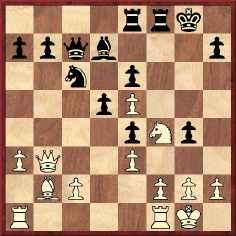
19 Qb5 Nd4 20 Qb4 Nxc2 21 Rac1 Rc8 22 Qd2 Qc4 23 Qd1 Rxf4 24 exf4 h5 25 f5 exf5 26 Rxc2 Resigns.
(4783)
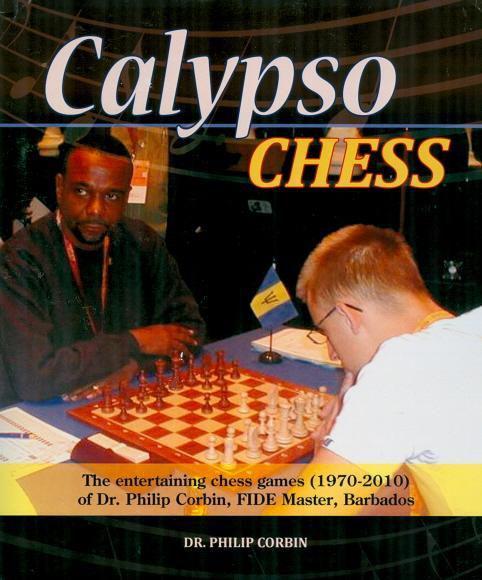
There is much lively chess in Calypso Chess by Philip Corbin (Saint Peter, 2011), a 441-page annotated games collection from Caribbean Chapters Publishing. Nigel Short’s Foreword remarks that ‘Dr Philip Corbin’s irresistibly infectious, boyish enthusiasm permeates its every page’.
Among the highlights are the games against Freedman (pages 60-61), Chubinsky (pages 93-95), N.N. (pages 121-122) and Greenidge (pages 223-224). The last of these reached a curious symmetrical position after six moves (1 b4 b5 2 e4 e5 3 Bb2 Bb7 4 Bxe5 Qe7 5 Bxc7 Bxe4 6 Qe2 Bxc2):
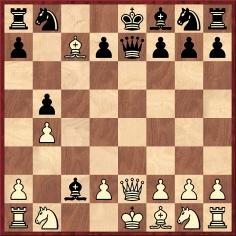
(7373)
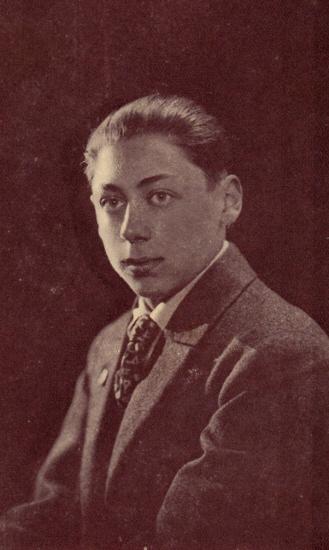
This photograph of Paul Limbos was published opposite page 376 of L’Echiquier, September 1929. As mentioned on page 402 of the same issue, he was aged 15 at the time:
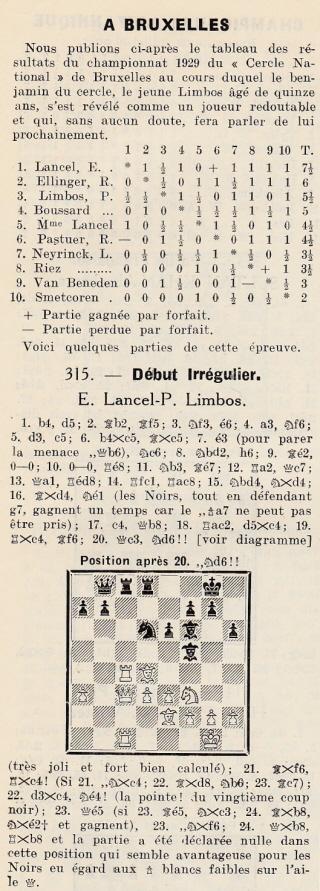
1 b4 d5 2 Bb2 Bf5 3 Nf3 e6 4 a3 Nf6 5 d3 c5 6 bxc5 Bxc5 7 e3 Nc6 8 Nbd2 h6 9 Be2 O-O 10 O-O Re8 11 Nb3 Be7 12 Ra2 Qc7 13 Qa1 Red8 14 Rc1 Rac8 15 Nbd4 Nxd4 16 Bxd4 Ne8 17 c4 Qb8 18 Rac2 dxc4 19 Rxc4 Bf6 20 Qc3 Nd6 21 Bxf6 Rxc4 22 dxc4 Ne4 23 Qe5 Nxf6 24 Qxb8 Rxb8 Drawn.
(8536)
From page 57 of the BCM, February 1948 in a report on Hastings 1947-48:
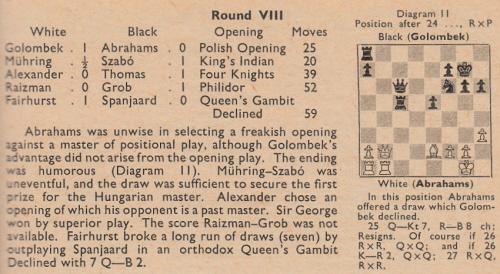
The game was ‘annotated’ by W.H. Pratten on page 121 of the February 1948 CHESS:
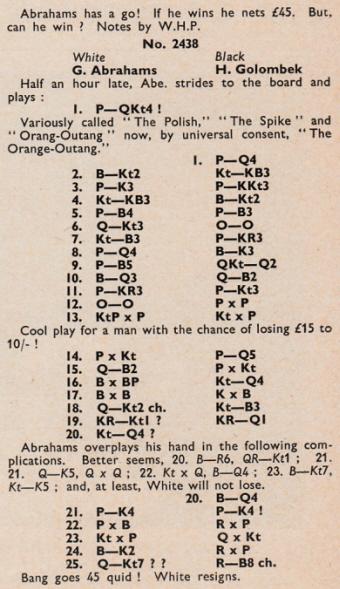
Although sometimes dated 1947, the game was played on 6 January 1948, as reported on page 7 of the Times the following day.
(8842)
Citations regarding ‘The Spike’ are sought.
A surprising passage from pages 292-293 of Modern Chess Opening Traps by William Lombardy (New York, 1972):
‘Orangutan Opening
This opening, named after a gangling ape, was so dubbed at a time when 1 P-K4 and 1 P-Q4 were thought to be the only normal and therefore the only satisfactory debuts. Today such grandmasters as Pal Benko, Bent Larsen and William Lombardy have brought the opening into true prominence so that 1 P-QN4 may be considered as regular as any other opening. The obvious theme is the early attempt to gain a central pawn for a flank pawn, an exceptionally good bargain.’
(8843)
C.N. 10225 mentioned Capablanca’s well-known loss to Kevitz with
1 b4 in a simultaneous exhibition. C.N. 2720 gave an even shorter
loss, to A. Kramer.
A win by Léonardus Nardus, played at the Café de la Régence and published on pages 103-104 of La Stratégie, March 1913:
Vladimir Bienstock – Léonardus Nardus
Paris, January 1913
‘Hunt Opening’
1 b4 d5 2 Bb2 Bf5 3 d4 e6 4 a3 Nf6 5 e3 Bd6 6 c4 c6 7 c5 Bc7 8 Bd3 O-O 9 Bxf5 exf5 10 Qd3 Ne4 11 Ne2 Qg5 12 g3 Nd7 13 Nbc3 Ndf6 14 f3 Nxc3 15 Bxc3 Rae8 16 Bd2 Qh5 17 Kf2
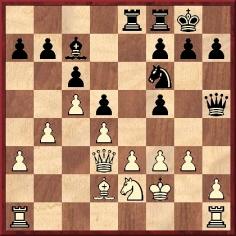
17…Ne4+ 18 fxe4 fxe4 19 Qc2 Qf3+ 20 Kg1 Qxe2 21 Re1 Qg4 22 Rf1 Bxg3 23 White resigns.
An extract from our feature article on Frank Crowl:
From page 132 of the 1 July 1946 issue of C.J.S. Purdy’s magazine Chess World:
‘Frank A. Crowl, the Australian Nimzowitsch, as we long ago dubbed him, is a player who cares absolutely nothing for orthodox theories. Even the almost universally accepted idea that White has an advantage by moving first is contradicted by him. Inspired by some articles in the old Wiener Schachzeitung (a great chess fortnightly [sic] which died when Hitler acquired Austria), he believes that the perfect game of chess would be won by Black. No-one can prove the contrary.’
The Chess World article concerned the previous year’s Victorian championship, and a specimen of Crowl’s play was introduced as follows:
‘The first game was considered by Dr Gellis [Max Gellis, the tournament winner] the best of the tourney, and when he himself was awarded the best-game prize for his game against Crowl he handed it over to Crowl – a typically Viennese gesture.’
Frank Arthur Crowl – J.A. Erksine
Victoria, 1945
Polish Opening1 b4 (‘I have nearly reached the conclusion that this is the only opening left now which offers White winning chances.’ – Crowl.) 1...Nf6 2 Bb2 e6 3 b5 Be7 4 e3 O-O 5 f4 c5 6 Nf3 a6 7 Nc3 d6 8 a4 Nbd7 9 Be2 axb5 10 axb5 Rxa1 11 Qxa1 Nb6 12 O-O Bd7 13 e4 Qa8 14 g3 Qxa1 15 Rxa1 Ra8 16 Rxa8+ Nxa8 17 e5 Ne8 18 Ba3 d5 19 d4 cxd4 20 Bxe7 dxc3
21 Bd8 Nec7 22 Nd4 Kf8 23 b6 Ne8 24 Bb5 Bc8 25 Kf2 f6 26 Ke3 fxe5 27 fxe5 g6 28 Kd3 Ng7 29 g4 Kf7 30 Kxc3 h6 31 Kb4 Ne8 32 Kc5 Kf8
33 Bd3 Kf7 34 Nb5 g5 35 Nd6+ Nxd6 36 Kxd6 Ke8 37 Bc7 Kf7 38 Bb5 Resigns.
We turn now to 1...b5. The examples below go as far as the 1930s and omit relatively well-known games, the most famous probably being M. Euwe v G. Abrahams, Bournemouth, 1939.
(4014)
Concerning one of the games listed in C.N. 4014 above, Hicks v Chajes, Eduardo Bauzá Mercére (New York, NY, USA) reports that it was played in the Manhattan Chess Club championship and was published by Hermann Helms on page 16 of the New York Evening Post, 9 February 1918:

1 d4 b5 2 Nf3 Bb7 3 e3 a6 4 c4 bxc4 5 Bxc4 e6 6 Nbd2 Nf6 7 h3 Be7 8 b3 Nc6 9 Bb2 Nb4 10 O-O O-O 11 Ba3 Ne4 12 Nxe4 Bxe4 13 Nd2 Bb7 14 Be2 f5 15 f4 Nd5 16 Bxe7 Qxe7 17 Nc4 Nc3 18 Qd3 Nxe2+ 19 Qxe2 Rf6 20 Rac1 Rg6 21 Rf2 d6 22 Nd2 Bd5 23 e4 fxe4 24 Nxe4 Rf8 25 Nc3 Bb7 26 d5 Rf5 27 Re1 e5 28 Kh2 Qh4 29 g4
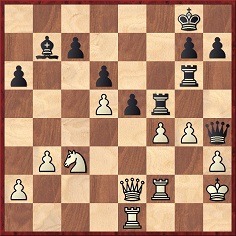
29...h5 30 gxf5 Rg3 31 Qf1 Rxc3 32 Qg2 Rxh3+ 33 Qxh3 Qxf2+ 34 Qg2 Qxe1 35 Qg6 Qh4+ 36 Kg1 Qg4+ 37 Qxg4 hxg4 38 fxe5 dxe5 39 Kg2 Bxd5+ 40 Kg3 Bf3 41 b4 Kf7 42 a3 Kf6 43 White resigns.
(9665)
Alan McGowan (Waterloo, Canada) has the following Kurt Richter games in his collection:
Ahues v Richter
Berlin-Freien Turnier-1st Class, 1925
1 d4 b5 2 e4 Bb7 3 Nd2 a6 4 c3 e6 5 Ngf3 d6 (½-½, 46)
Source: Deutsches Wochenschach, 1925, pages 52-53.Helling v Richter
Berlin Championship, 1926
1 d4 b5 2 e4 Bb7 3 Bd3 Nf6 4 Qe2 e6 5 f4 Nc6 6 Nf3 (0-1, 33/34)
Source: Kurt Richters Beste Partien by A. Brinckmann (1939 and 1961 editions).Grammatikoff v Richter
Berlin Championship, 1936
1 d4 b5 2 e4 Bb7 3 f3 b4 4 Be3 e6 5 Nd2 f5 6 Bd3 Nf6 (0-1, 40)
Source: Kurt Richters Beste Partien by A. Brinckmann (1939 edition).Lehmann v Richter
Willi Schlage Memorial Tournament, Berlin, 1940
1 d4 b5 2 a4 b4 3 c4 Nf6 4 Nf3 Bb7 5 g3 c5 6 Bg2 (1-0, 41).
Our correspondent adds:
‘Kurt Richter played ...b5 on many other occasions, although most such games opened 1 d4 Nf6 2 Nf3 b5. Flohr v Richter, Poděbrady, 1936 began 1 Nf3 b5 (½-½, 21).’
(4032)
The game H.E. Atkins v Fred Brown in the Birmingham tournament began 1 d4 b5 2 e4 a6 (Chess Player’s Chronicle, 19 April 1899, pages 70-72).
(9795)
P.J. Doyle – Albert Cohnfeld
New York, 30 September 1877
1 b4 e5 2 Bb2 d6 3 c4 Be7 4 Nc3 f5 5 e3 Nf6 6 d4 exd4 7 exd4 O-O 8 Nf3 Ne4 9 Be2 Nd7 10 O-O Ndf6 11 h3 Qe8 12 a3 Nxc3 13 Bxc3 Ne4 14 Qc2 Qg6 15 Bd3 Bf6 16 Bb2 Re8 17 Rae1 Bd7 18 Re3 Re7 19 Bc1 Rae8 20 d5 f4 21 Bxe4 Rxe4 22 Rxe4 Rxe4 23 Nd2 Bf5 24 Qb3 Rd4 25 Kh2 Rd3 26 Qa2 Qh5 27 f3 Qh4 28 Ne4 Bxe4 29 fxe4 Qg3+ 30 Kg1 Be5 31 Qe2 f3 32 Rxf3 Rxf3 33 Qxf3 Qe1+ 34 White resigns.
Source: Dubuque Chess Journal, December 1877, page 322.
William M. De Visser – Peters
New York, circa 1879
1 b4 e5 2 Bb2 d6 3 c4 Nf6 4 e3 Be7 5 Be2 Bd7 6 a3 b6 7 Nf3 Bc6 8 d4 exd4 9 exd4 O-O 10 d5 Bd7 11 Bd3 Ne8 12 Qc2 h6 13 O-O c5 14 Nc3 Bg4 15 Kh1 Nd7 16 h3 Bh5 17 Ne4 Bg6 18 Rae1 Kh8 19 Nh2 Ndf6 20 f4 Nxe4 21 Bxe4 Bxe4 22 Qxe4 Bf6 23 Bc1 Bc3 24 Rd1 f5 25 Qf3 cxb4 26 axb4 Bxb4 27 g4 Bc5 28 g5 Kh7 29 Bb2 Qd7 30 Rde1 Qf7 31 Re6 hxg5 32 fxg5 g6 33 Qh5+ gxh5 34 Rh6+ Kg8 35 Rh8 mate.
Source: Newark Sunday Call, 2 March 1879.
Preston Ware – Henry William Birkmyre Gifford
Paris, circa 1882
1 b4 e5 2 Bb2 f6 3 a3 d5 4 e3 Bd6 5 c4 dxc4 6 Bxc4 Ne7 7 Ne2 Bf5 8 d4 exd4 9 Nxd4 Qd7 10 O-O Nbc6 11 Nc3 Nxd4 12 Qxd4 Be6 13 Rfd1 Rd8 14 Bxe6 Qxe6 15 Qxa7 O-O 16 Qxb7 Qb3 17 Rab1 Be5 18 Rdc1 Rd3 19 Ba1 Qxa3 20 Nb5 Qa2 21 Nd4 Rd2 22 Qf3 Ng6 23 g3 Bd6 24 Nb3 Ne5 25 Qg2 Re2 26 Nd4 Rd2 27 Bc3 Nd3 28 Ra1 Rxf2 29 Rxa2 Rxg2+ 30 Kxg2 Nxc1 31 Rd2 Ra8 32 Nb5 Na2 33 Nxd6 Nxc3 34 Rc2 Ra2 35 Rxa2 Nxa2 Drawn.
Source: Chess Player’s Chronicle, 24 May 1882, page 247.
(11895)
Addition on 19 October 2021:
Alan Smith (Stockport, England) submits the following game from page 6 of the Croydon Guardian, 5 February 1881, won at the Leicester Club in 1881 by Joseph Steele (the Guardian’s columnist) against a player named Atkins:
1 d4 b5 2 e4 Bb7 3 d5 b4 4 a3 c5 5 axb4 cxb4 6 Bd2 e6 7 dxe6 dxe6 8 Bb5+ Bc6 9 Qe2 Bxb5 10 Qxb5+ Qd7 11 Qe2 a5 12 Nf3 Bc5 13 Ne5 Qb7 14 Nxf7 Qxf7 15 Qb5+ Nd7 16 O-O Ngf6 17 Rxa5 Rxa5 18 Qxa5 O-O 19 Bxb4 Nxe4 20 Bxc5 Ndxc5 21 f3 Nd7 22 Rd1 Nef6 23 c4 Qe7 24 b4 Rb8 25 c5 Nd5 26 c6 Ne5 27 b5 Qc5+ 28 White resigns.
To the Chess Notes main page.
To the Archives for other feature articles.
Copyright: Edward Winter. All rights reserved.